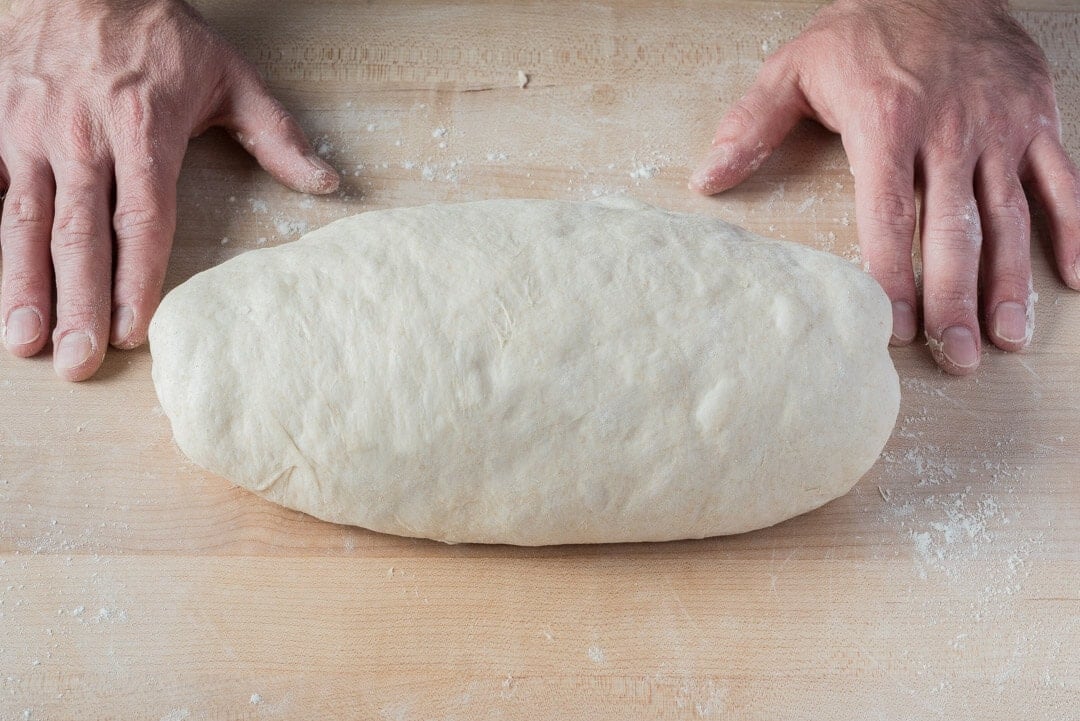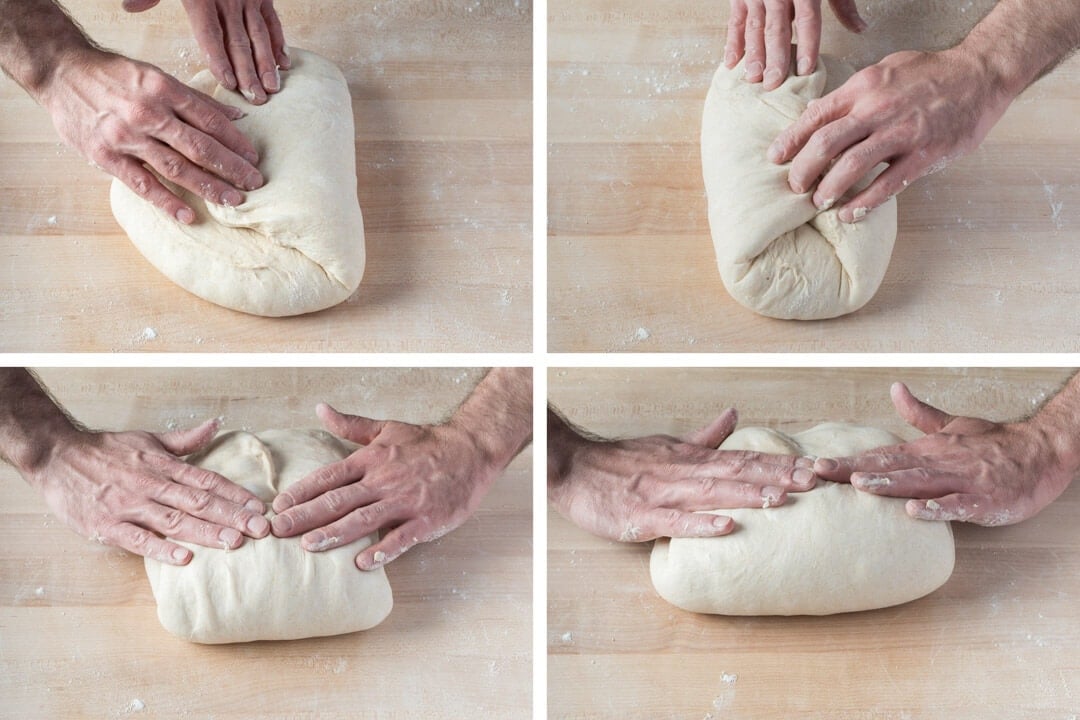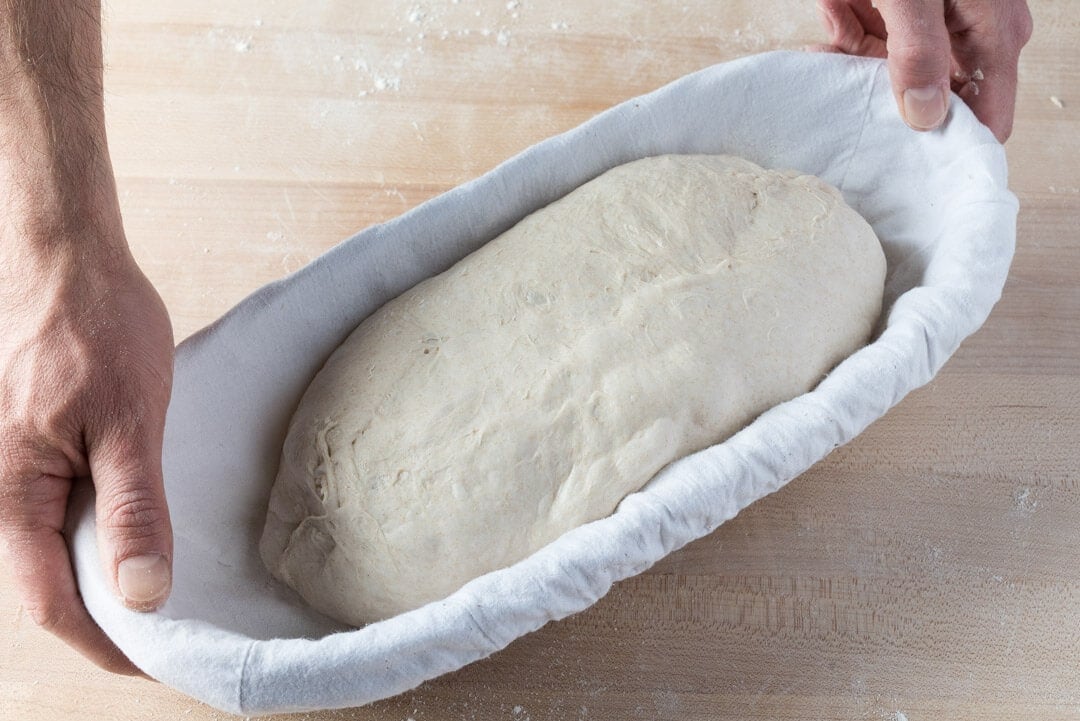I’m unsure what first drew me to this elegant way of shaping bread dough. Something about the curves, the opening, the way it slices up—and that dark line from a long single slash—gets me every time. Shaping bread dough into a bâtard shape results in nothing more than dough shaped into an oblong, but it feels like much more.
Note that if you’re baking your bread inside of Dutch oven, you may not be able to fit an oval loaf like this into the pot, which is typically round.
What is a bâtard?
Bâtard is a French term for an oval or oblong loaf. It’s simply bread dough shaped into a football-like oval which may or may not have dramatically tapered ends. The degree to which the ends taper—ranging from a sharp point to a blunt round—varies based on the baker and the type of bread they’re baking.
How to practice shaping a bâtard
Shaping a bâtard successfully takes practice. One way to practice is to use a folded-up dish towel in place of the dough. First, lay out a square in front of you and follow my steps below to first fold in the sides. Then, roll up the towel with your hands and fingers, with a finishing tuck to keep it tight. I remember doing this repeatedly when I first embarked on this method, which helped.
If you’re just starting baking, I recommend shaping your bread dough as a boule (round) first. It has fewer motions and more room for taking things slowly.
Video of me shaping a bâtard two ways
The video below shows my two methods for shaping bread dough into a bâtard (oval) shape. I take one of two approaches when shaping an oval loaf of bread:
- The first method is for a dough that’s more slack and weak, requiring more structural support.
- The second method is for a stronger dough that requires only a light hand when shaping.
What baskets should I use to proof a bâtard?
| Basket Length | Divided Dough Weight |
|---|---|
| 10 to 11-inches | 600 to 900 grams |
| 14-inches | 900 grams or more |
For each piece of dough shown in this guide, I scaled it at 900g after bulk fermentation. At this weight, I prefer using long 14″ proofing baskets that allow the dough to relax outward toward the top and bottom during the final proof. This basket size gives the dough enough room to fill the basket and rise into a long batard.
Currently, I’m sourcing these baskets from the San Francisco Baking Institute, but you can see all my favorite proofing containers on my baking tools page.
Shaping a bâtard step by step
- Starting with a preshaped and rested round, first flip the round onto a lightly floured surface and gently stretch the round out to fill a circle
- Fold the left side of the circle out and over to a little past the middle
- Fold the right side of the circle out and over to about the middle, just overlapping the left side that was just folded
- With two hands, grab the top of the rectangle before you and gently stretch it away from your body. Then pick it up and fold it down over the rest of the dough just a ways
- Using your two index fingers or thumbs, press the top of the folded down into the rest of the dough so it lightly seals
- Continue picking up from the top and rolling the entire mass down, sealing at each fold-over
Try to avoid compressing the center with too much pressure with each roll. In other words, when you pick up the top and fold it over, exaggerate the motion of picking up and rolling down: less like rolling up a tight towel and more like rolling up a big ball.
After the final tuck with your fingers, the dough should be smooth on the outside with a firm surface. Remember, this dough will now undergo a long proof time and needs to be shaped with enough strength to make it to the oven without spreading outward excessively.
Using your bench knife and another hand, flip the shaped oval into your proofing basket seam-side-up. At this point, you can make small adjustments in the basket if your dough isn’t entirely centered. Additionally, gently pinching the dough’s ends can help exaggerate the oval shape.
A video of me shaping a bâtard in slow motion
This slow-motion video illustrates how this all comes together as I shape a single round. Note that the dough weight shown here was 900g, and it was preshaped into a loose round, then left to relax for 30-40 minutes before shaping.
For more videos like this, check out my Instagram feed and my YouTube channel, where I routinely post new videos while baking in my home kitchen.
What next?
See my guide to shaping bread dough for other shapes, such as a round boule, pan loaves, or even baguettes.
Almost all recipes here at The Perfect Loaf can be modified so the bread can be shaped as a batard (except for some of the more specialty shapes). Start with my Beginner’s Sourdough Bread recipe, which would make an excellent batard!
Happy baking!




